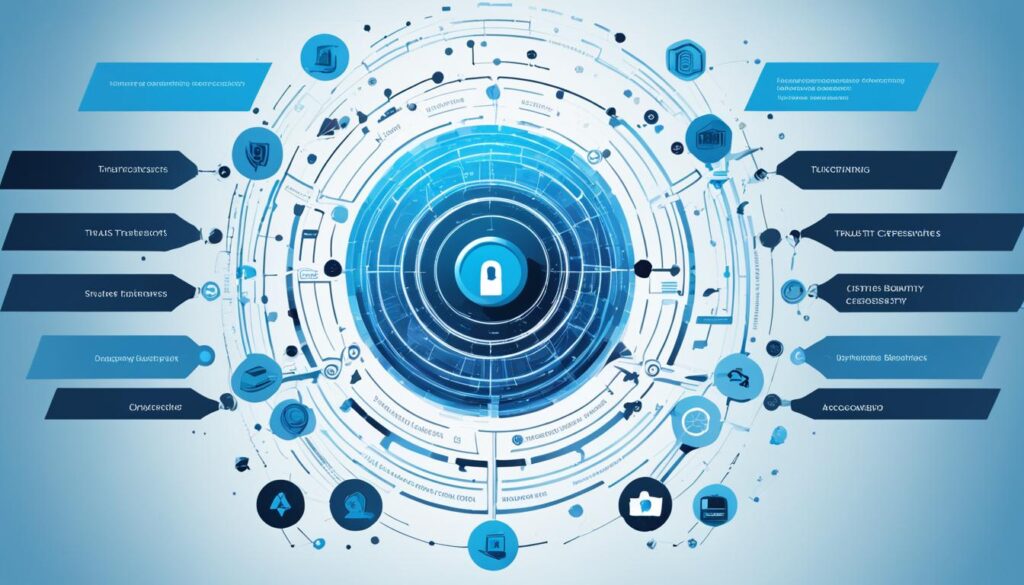10 Top Cybersecurity Trends to Watch in 2024
Thursday, 5/9/2024, 8 minutes to read

As we peer into the complex digital expanse of 2024, the cybersecurity landscape reveals an ever-evolving theatre of operations where cyber threat predictions foretell a landscape demanding increasingly sophisticated defensive strategies. The forthcoming year teems with potential for cybersecurity innovations, which seek to address the multi-faceted cybersecurity challenges in 2024. Within this piece, we will unmask the curated advancements and the pivotal data protection trends shaping the future of information security.
Fostering a proactive stance against burgeoning digital threats, experts emphasize a necessity for agility and preparedness. This narrative encapsulates holistic approaches encompassing regulatory compliance, technological advancements, and the imperative consolidation between them to fortify digital defenses. As the threshold of innovation continually expands, so too our understanding and capabilities must advance to protect the increasingly interconnected fabrics of our digital lives.
Key Takeaways
- Analyzing the impact of regulatory initiatives on cybersecurity practices.
- Exploring cutting-edge technologies poised to combat cyber threats.
- Understanding the pivotal role of machine learning and artificial intelligence in safeguarding data.
- Prognosticating the escalation of threats and corresponding security measures required.
- Assessing the interdependence of privacy regulations and information security developments.
Emerging Threats in the Cyber Landscape
The cybersecurity arena is progressively challenged by sophisticated threats that jeopardize everything from individual privacy to global infrastructure. Understanding these threats is paramount as technology evolves and integrates deeper into our daily lives and the operational frameworks of our societies.
Advanced Persistent Threats (APTs) Evolving Techniques
APTs represent a significant segment of modern cyber threats due to their stealthy nature and long-term objectives. These threats continue to evolve, employing more cunning strategies that slice through traditional security defenses with terrifying efficiency. The motive behind APTs often stretches beyond immediate financial gain, aiming instead at acquiring confidential data or undermining critical operations, necessitating enhanced measures in critical infrastructure protection.
The Rise of AI-Enhanced Cyber Attacks
The integration of Artificial Intelligence in cyber-attacks presents a dual-edged sword. On one hand, AI provides monumental advancements in threat detection and response systems; on the other hand, it equips cybercriminals with powerful tools to engineer more complex AI cyber threats. These AI-driven attacks are capable of learning from and adapting to the defensive measures they encounter, making it imperative for cybersecurity systems to continually evolve to outsmart this adaptive threat landscape.
Threats to Critical Infrastructure and IoT Devices
The escalation in smart device deployment in sectors such as healthcare, transportation, and energy has led to increased vulnerabilities, making IoT security an essential component of modern cyber defense strategies. These devices often lack robust security features, providing a gateway for attackers to compromise critical systems. A concerted effort is necessary to uplift the security standards governing these devices to shield them from potential exploitation.

To elaborate further on the landscape of emerging threats, a comparison of sectors impacted by specific types of cyber threats provides a clearer view:
| Type of Threat | Affected Sector | Impact |
|---|---|---|
| APTs | Government, Defense | Data theft, Espionage |
| AI Cyber Threats | Finance, Technology | Automated Frauds, Data Breaches |
| IoT Security Breaches | Healthcare, Consumer Devices | Personal Information Leak, Service Disruption |
As we navigate the digital age, the fusion of cutting-edge technology with proactive security measures becomes increasingly critical. Staying informed and vigilant against these emerging threats is imperative for protecting the facets of society that are most vulnerable to cyber disruptions.
The Paradigm Shift in Cybersecurity Methodologies
The landscape of cybersecurity is witnessing a significant transformation, pivoting from a traditionally reactive posture to more proactive cybersecurity strategies. This shift is crucial in the digital era, where threats evolve rapidly and the cost of breaches continues to climb.
At the forefront of this shift is the adoption of the zero-trust security model. Unlike conventional security frameworks that operate on the outdated assumption that everything inside an organization’s network should be trusted, the zero-trust model operates on a principle of „never trust, always verify,” which is becoming essential in a landscape where threats can emerge from anywhere.

Integrating machine learning in cybersecurity is another key element driving this paradigm shift. Machine learning algorithms are excellent at detecting patterns and anomalies that deviate from normal behaviors, which helps in predicting and mitigating potential threats before they can cause harm. This capability is complemented by behavioral analytics, which scrutinizes user behaviors to flag potentially malicious activities.
- Proactive Monitoring: Continuous assessment of system activities to pre-emptively identify and address vulnerabilities.
- Behavioral Analytics: Utilizing user data to understand typical behavior patterns and spot deviations that might indicate a security event.
- Machine Learning Implementation: Applying AI technologies to sharpen threat detection capabilities and speed up reaction times.
By weaving these advanced technologies and methodologies into the fabric of their cybersecurity strategies, organizations are not only enhancing their defensive posture but are also setting new benchmarks for the industry. This proactive approach is essential for staying ahead of cybercriminals in the ever-evolving digital landscape.
The Expansion of Cybersecurity Regulations and Compliance Needs
In today’s rapidly evolving digital world, the importance of adhering to stringent cybersecurity regulations and robust compliance management frameworks has never been more critical. As businesses and organizations worldwide strive to protect their data and systems, international cybersecurity regulations like the GDPR, HIPAA, and adherence to NIST guidelines play pivotal roles. These standards not only enforce legal obligations but also help foster a trusting relationship between services and their users.
Global Data Protection and Privacy Laws
Legislation like the General Data Protection Regulation (GDPR) impacts businesses globally, imposing strict rules on data breach notifications and the clear consent of data subjects. The ripple effects of such international cybersecurity regulations emphasize the need for effective compliance management tools and strategies, ensuring businesses can meet these comprehensive requirements.
Industry-Specific Cybersecurity Standards
Within specific sectors, such as healthcare, compliance with standards like HIPAA is essential, not just for legal compliance but for safeguarding sensitive patient information. Detailed adherence to industry-specific regulations like HIPAA demonstrates the complexities and strategic necessities of tailored cybersecurity frameworks that cater to unique sector demands.
Cross-Border Cybersecurity Frameworks
The digital age knows no borders, which is illustrated by the necessity for cross-border cybersecurity frameworks that synchronize security efforts across nations. This international cooperation is crucial not only for conducting business on a global scale but also for maintaining comprehensive security in the interconnected cyber ecosystem.
As we continue to witness the expansion of these regulations, compliance management becomes not merely a requirement but a strategic advantage in securing enterprises and maintaining public trust in technology and digital interfaces. The interplay between well-established standards like NIST and emergent international frameworks will certainly shape the future landscape of global cybersecurity practices.
Conclusion
As we look toward the cybersecurity outlook 2024, we anticipate a dynamic landscape where the agility and innovativeness of defense strategies will determine the robustness of our digital environments. The emerging threats discussed previously not only serve as a cautionary forecast but also as a catalyst for the avid development of sophisticated cyber defense strategies. Reflecting on the explored themes, it is evident that the collective endeavor of industry professionals, organizations, and regulators is pivotal in curating a secure digital future.
The insights provided in this article assert the notion that vigilance is no longer discretionary but mandatory. In a world where threats evolve in tandem with technology, embracing a proactive posture and integrating advanced analytics and AI into our security suite is no longer futuristic—it’s essential. And as our digital infrastructure becomes more interconnected, the importance of adhering to global standards and frameworks will fortify our collective cyber resilience.
In conclusion, the commitment to fortifying cybersecurity measures is a continuous process that demands innovation, adaptability, and unwavering attention. The steps we take today to embrace emerging technologies and uphold stringent security protocols are the foundation upon which a secure 2024 rests. By preparing for the outlined challenges and employing robust security measures, organizations and individuals alike can strive to stay ahead in a perpetually evolving digital battleground.
FAQ
What are the top cybersecurity trends to watch for in 2024?
In 2024, key cybersecurity trends will include proactive cybersecurity measures, the integration of machine learning and behavioral analytics, cybersecurity innovations such as the zero-trust security model, and the rise of AI-enhanced cyber attacks. Additionally, increased attention will be given to data protection trends, especially in critical infrastructure and IoT security.
How are cyber threats expected to evolve in the near future?
Cyber threats are anticipated to become more sophisticated, with Advanced Persistent Threats (APTs) using more complex techniques to evade detection. AI is also expected to play a larger role, both in enhancing cyber defense and in creating more advanced cyber attacks. Attacks on critical infrastructure and Internet of Things (IoT) devices are likely to rise, requiring new defense mechanisms.
What changes are occurring in cybersecurity methodologies?
The cybersecurity industry is witnessing a shift from reactive to proactive methodologies. This entails adopting a zero-trust security model, implementing continuous monitoring, and leveraging machine learning and behavioral analytics to preemptively identify and neutralize threats.
How will regulatory changes impact cybersecurity in 2024?
Cybersecurity in 2024 will be heavily impacted by the expansion and enforcement of global data protection and privacy laws, such as GDPR, as well as industry-specific standards like HIPAA. Compliance management will become more complex due to these changes, and organizations will need to navigate through various international cybersecurity regulations and frameworks.
How should businesses prepare for future cyber threat predictions?
Businesses should prepare for the future by staying informed about cybersecurity challenges in 2024, adopting proactive cyber defense strategies, ensuring compliance with international cybersecurity standards, and investing in the latest cybersecurity innovations to protect against evolving digital threats.
Why are AI cyber threats significant, and what can be done to mitigate them?
AI cyber threats are significant due to their potential to automate attacks, personalize phishing attempts, and execute complex strategies that can be more difficult to detect. Mitigation involves investing in AI-powered security solutions, continuous system monitoring, and regular cybersecurity training for employees to recognize and respond to AI-generated threats.
Other blog posts
Revolutionize your business with cutting-edge technology!
Let’s Bring Your Vision to Life—Contact Us Today!
📝 Get an Estimate